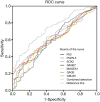The role of seven autoantibodies in lung cancer diagnosis
- PMID: 34277058
- PMCID: PMC8264704
- DOI: 10.21037/jtd-21-835
The role of seven autoantibodies in lung cancer diagnosis
Abstract
Background: To investigate the expression and diagnostic value of seven autoantibodies (P53, PGP9.5, SOX2, GAGE7, GBU4-5, MAGE, and CACE) in lung cancer patients.
Methods: A total of 370 patients were admitted to the Thoracic Surgery of the First Affiliated Hospital of Suzhou University from 2017 to 2019, including 305 patients with lung cancer and 65 patients with benign lesions. The concentrations of the seven autoantibodies were determined by enzyme linked immunosorbent assay (ELISA).The expression levels of each antibody were compared between the two groups, and the levels of each antibody between lung cancer patients with different pathological types were also compared. We aimed to analyze the diagnostic efficiency of single antibody detection combined with seven antibodies, and also to explore whether there were differences among the positive rates of each antibody in sex, age, smoking history, pathological classification, and clinical stages in the lung cancer group.
Results: The expression levels of seven autoantibodies in the lung cancer group were higher than those in the benign lesion group. In the lung cancer group, the expression levels of the seven autoantibodies did not vary statistically among different pathological types. The area under the curve of combined detection of the seven antibodies reached 0.735, and the Y-index reached 0.35, which was higher than that of single antibody detection. P53 exhibited the highest sensitivity and lowest specificity; meanwhile, PGP9.5, SOX2, GAGE7, GBU4-5, and MAGEA1 exhibited low sensitivity and high specificity. The sensitivity and specificity of the CAGE were approximately 60%, respectively. There was no statistical difference in the positive rate of each antibody in age, smoking history, and clinical stage. The positive rate of MAGEA1 and CAGE was statistically different in sex, and the positive rate of MAGEA1 was statistically different in pathological classification.
Conclusions: The seven autoantibodies of lung cancer can potentially be used as an auxiliary examination method for the early diagnosis of lung cancer.
Keywords: Lung cancer; diagnosis; seven autoantibodies.
2021 Journal of Thoracic Disease. All rights reserved.
Conflict of interest statement
Conflicts of Interest: All authors have completed the ICMJE uniform disclosure form (available at https://dx.doi.org/10.21037/jtd-21-835). The authors have no conflicts of interest to declare.
Figures
References
LinkOut - more resources
Full Text Sources
Research Materials
Miscellaneous

